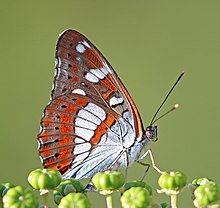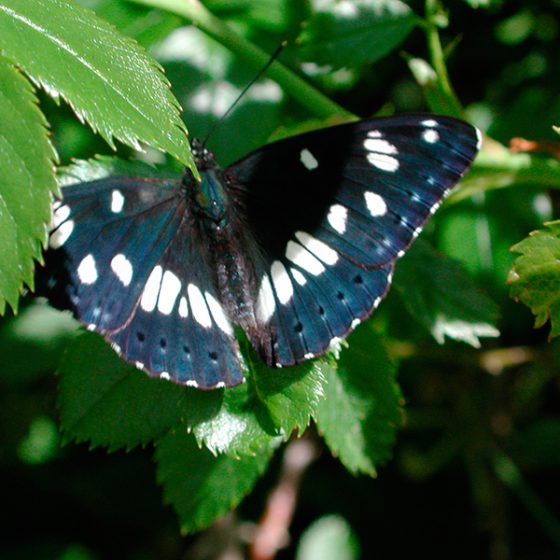Limenitis reducta – Staudinger, 1901
Descrizione
Farfalla diurna della famiglia dei Ninfalidi.
Si trova fino a m 1300 s.l.m. (circa), ama volare in prossimità di aree boscate o filari di alberi; le principali piante ospiti sono varie specie del genere Lonicera.
Specie termofila, si vede più facilmente quando splende il sole.
In Italia è diffusa in tutte le regioni, isole comprese. Un tempo, in particolare, si riteneva specie meridionale vicariante della Limenitis camilla (decisamente più settentrionale e montana appenninica). Oggi, tuttavia, le prime L. camilla iniziano a comparire anche in Italia centrale…
Si riconosce dalla specie consimile Limenitis camilla per gli elementi che seguono (come ben precisato da Paolo Mazzei nel forum di www.naturamediterraneo.com):
- la reducta ha una sola banda di punti neri nell’ala posteriore e le macchie bianche sono ben riconoscibili (più definite)
- la camilla, invece, nell’ala posteriore ha due bande di punti neri
Specie simili
Limenitis camilla – Linnaeus, 1764
Descrizione
Farfalla diurna della famiglia dei Ninfalidi, ama gli ambienti boschivi, si nutre del nettare dei fiori di rovo e, dove presente, è relativamente facile ammirarla, da giugno ad agosto, mentre vola ad altezza d’uomo.
Posata al sole, si mimetizza tra il fogliame per la sua livrea marrone scura a macchie bianche facilmente confondibile tra le luci e le ombre della vegetazione.
Il bruco si nutre di caprifoglio e sverna nel fitto del sottobosco.
Nell’Italia centrale inizia a comparire qua e là con sempre maggior frequenza…
Specie affine è la Limenitis reducta.
Galleria
Limenitis reducta - silvano azzurro, piccolo silvano
 Link da Moths and Butterflies of Europe and North Africa [www.leps.it]: Limenitis reducta – Staudinger, 1901
Link da Moths and Butterflies of Europe and North Africa [www.leps.it]: Limenitis reducta – Staudinger, 1901
Contents
Limenitis reducta
| Limenitis reducta | |
|---|---|

| |
| Upperside, North Macedonia | |

| |
| Underside, Sithonia, Greece | |
| Scientific classification | |
| Domain: | Eukaryota |
| Kingdom: | Animalia |
| Phylum: | Arthropoda |
| Class: | Insecta |
| Order: | Lepidoptera |
| Family: | Nymphalidae |
| Genus: | Limenitis |
| Species: | L. reducta
|
| Binomial name | |
| Limenitis reducta Staudinger, 1901
| |
| Synonyms[14] | |
|
List
| |
Limenitis reducta, the southern white admiral, is a butterfly of the family Nymphalidae.
Subspecies
- Limenitis reducta reducta Staudinger, 1901
- Limenitis reducta herculeana Stichel, 1909[15]
Distribution and habitat
This species can be found in central and southern Europe (northern Iberia, southern and eastern France, Italy, the Balkans, and the Alps),[16] in Western Asia, in Syria, the Caucasus and Iran.[17][18] These butterflies live in light woodland, in woodland glades and in forest edge, at an elevation of 0–1,650 metres (0–5,413 ft) above sea level.[19]
Description
Limenitis reducta has a wingspan of 46–54 mm.[19] The upperside of the wings is brown black with metallic blue shine, large transversal band of white markings and a submarginal line of small blue dots. The blue sheen varies with the angle of light. The ground colour of underside of the hindwings is red, with a silvery basal area, a row of white markings and a row of black spots. A few white cell spots are also present on the underside of the forewings.[16][19] The caterpillars can reach a length of 27 millimetres (1.1 in). They are light green to dull green on the back, red brown on the underside. On the back there are numerous brown thorns.
This species is rather similar to Limenitis camilla, Neptis rivularis and Araschnia levana f. prorsa.
-
Dorsal side
-
Ventral Side
Biology
This species may have one or more generations, depending on the location.[16] The butterfly flies from May to August depending on the location.[19] Larvae feed on honeysuckle (Lonicera periclymenum, Lonicera etrusca, Lonicera implexa, Lonicera xylosteum, Lonicera alpigena, and Lonicera caprifolium).[18] Adults usually feed on nectar of a wide range of herbaceous and arboreal flowers, but also visit fallen fruits, dung, aphid secretions and mineralised moisture from damp ground.[20]
Bibliography
- Boulard (Michel), 1988.- Note sur la pariade du Sylvain azuré (Lep. Nymphalidae). Alexanor, 15 (3), 1987 (1988): 156-158.
- D.J. Carter & B. Hargreaves - Guide des chenilles d'Europe - Delachaux & Niestlé, 2012, (ISBN 9782603018460)
- Josef Settele, Roland Steiner, Rolf Reinhardt, Reinart Feldmann: Schmetterlinge. Die Tagfalter Deutschlands., Eugen Ulmer KG, 2005, ISBN 3-800-14167-1
- Tom Tolman, Richard Lewington - Guide des papillons d'Europe et d'Afrique du Nord, Delachaux & Niestlé, Paris 1997 - (ISBN 978-2-603-01649-7)
References
- ^ Denis & Schiffermüller, 1775 Ankündung eines systematischen Werkes von den Schmetterlingen der Wienergegend: 172
- ^ Esper, 1778 Die Schmett. Th. I, Bd. 1 (7): pl. 38, f. 2
- ^ Bergsträsser, [1779] Nomen. Ins., 3: pl. 67, f. 5-6
- ^ Miller, 1859 Icon. Lep. 2: pl. 2, f. 1
- ^ Lewis, 1872 Zoologist (2) 7 : 3074 (rej. ICZN-562)
- ^ Grund, 1908 Soc. ent. 23 (11) : 81
- ^ Fruhstorfer, 1909 Int. ent. Zs. 3 (17) : 94
- ^ Niepelt, 1914 Int. ent. Z. 8 (26) : 144
- ^ Lucas, 1923 Amat. Papillons: 50
- ^ Verity, 1924 Ent. Rec. Suppl. 36: 35,
- ^ Verity, 1928 Ent. Rec. 40 : 143
- ^ Higgins, 1933 Proc. R. ent. Soc. Lond. 7: 61
- ^ a b c d Verity, 1950 Le Farfalle diurn. d'Italia 4: 52
- ^ Lepiforum.de
- ^ Limenitis reducta herculeana Stichel, [1909] in Seitz, Grossschmett. Erde 1 : 183
- ^ a b c Euro Butterflies by Matt Rowlings
- ^ Fauna europaea
- ^ a b Funet
- ^ a b c d "Captain's European Butterfly Guide". Archived from the original on 2019-07-22. Retrieved 2017-02-01.
- ^ "Learn about butterflies". Archived from the original on 2017-04-20. Retrieved 2017-02-01.
External links
- Lepiforum de
- Lepi Net - Les Carnets du Lépidoptériste Français
- Moths and Butterflies of Europe and North Africa by Paolo Mazzei, Daniel Morel, Raniero Panfili
Limenitis camilla - camilla
 Link da Moths and Butterflies of Europe and North Africa [www.leps.it]: Limenitis camilla – Linnaeus, 1764
Link da Moths and Butterflies of Europe and North Africa [www.leps.it]: Limenitis camilla – Linnaeus, 1764
Contents
Limenitis camilla
| White admiral | |
|---|---|

| |

| |
| Both, Oaken Wood, Surrey, England | |
| Scientific classification | |
| Domain: | Eukaryota |
| Kingdom: | Animalia |
| Phylum: | Arthropoda |
| Class: | Insecta |
| Order: | Lepidoptera |
| Family: | Nymphalidae |
| Genus: | Limenitis |
| Species: | L. camilla
|
| Binomial name | |
| Limenitis camilla (Linnaeus, 1764)
| |
| Subspecies | |
| |
| Synonyms | |
| |
Limenitis camilla, the (Eurasian) white admiral, is a butterfly of the family Nymphalidae. It is found in woodland throughout southern Britain and much of temperate Eurasia[1] and the Palearctic, extending as far east as Japan.
Adult white admirals have dark wings with white bands. The contrasting colours help to break up the outline of the wing, camouflaging it from predators. They have a wingspan of approximately 60–65 mm and have a distinctive, elegant flight consisting of short periods of wing beats, followed by long glides.
The white admiral is typically found in shady woodland areas, where it feeds on bramble[1] blossom and honeydew and the female will lay its eggs singly on wisps of honeysuckle growing in dense woodland. The caterpillars are green with red-brown hairs and are camouflaged on a leaf by a mixture of their own droppings and silk. As autumn approaches it will form a tent-like structure made of leaf tissue known as a hibernaculum which it then secures to the stem with silk before hibernating. The caterpillar will then awaken the following spring and after a brief spell of feeding will moult, revealing a spiny green skin. It will then pupate during the summer, forming a green and gold chrysalis. After approximately two weeks the adult will emerge.
Larvae feed on Lonicera (L. japonica, L. xylosteum, L. tatarica, L. maackii, ) and Weigela .[2]
Description in Seitz
L. Camilla L. (= sibilla L., aucl. cet.)(57a, b). Very similar to the preceding species [sydyi L. sydyi Led. (female 57a). Blackish brown, with white spots on the forewing and a strongly elbowed white band on the hindwing; at the apex of the forewing, especially in the female, some reddish brown smears. Underside for the most part brownish, the hindwing bluish at the base and abdominal margin, in the distal area with 2 rows of blackish spots, the spots of the outer row being lunate and forming the borders of a further row of whitish spots. The females have a less intense ground-colour, the whitish submarginal spots of the hindwing and the light and reddish patches in the cell of the forewing are more distinct.]; however, the position of the spots of the forewing is different and the band of the hindwing is but slightly curved, not elbowed; on the underside the black spots in the marginal area of the hindwing are all rounded, there being no band of light spots outside them as in sydyi[ Limenitis sydyi Kindermann, 1853 East Palearctic]. [3]
Subspecies
Listed alphabetically:[2]
- L. c. camilla – Europe, Caucasus, Transcaucasia
- L. c. japonica Ménétriés, 1857 – Amur, Ussuri, Korea, China
-
Dorsal side
-
Ventral Side
-
Young caterpillar
-
Caterpillar
-
Larva in hibernaculum
-
Illustration from John Curtis's British Entomology Volume 5
Etymology
Named in the Classical tradition. Camilla in Greek mythology is an Amazon who died in the battle of the Rutuli with Aeneas.
External links
See also
References
- ^ a b Vila, Roger; Lohse, Konrad; Hayward, Alex; Laetsch, Dominik R.; Wellcome Sanger Institute Tree of Life programme; Wellcome Sanger Institute Scientific Operations: DNA Pipelines collective; Tree of Life Core Informatics collective; Wahlberg, Niklas; Darwin Tree of Life Consortium (2022-12-12). "The genome sequence of the white admiral, Limenitis camilla (Linnaeus, 1764)". Wellcome Open Research. 7: 301. doi:10.12688/wellcomeopenres.18594.1. ISSN 2398-502X.
- ^ a b "Limenitis Fabricius, 1807" at Markku Savela's Lepidoptera and Some Other Life Forms
- ^ Seitz. A. in Seitz, A. ed. Band 1: Abt. 1, Die Großschmetterlinge des palaearktischen Faunengebietes, Die palaearktischen Tagfalter, 1909, 379 Seiten, mit 89 kolorierten Tafeln (3470 Figuren)
 This article incorporates text from this source, which is in the public domain.
This article incorporates text from this source, which is in the public domain.



![Limenitis reducta, piccolo silvano [da wikimedia, photo by Didier Descouens Own work, CC BY-SA 4.0, commons.wikimedia.org/w/index.php?curid=40955266]](https://www.treviambiente.it/ambienteebiodiversita/wp-content/uploads/sites/9/2016/10/Limenitis_reducta_MHNT_CUT_2013_3_15_Buzet_Dos-wikimedia-web-560x560.jpg)
![Limenitis camilla, camilla [da wikimedia, photo by Didier Descouens Own work, CC BY-SA 4.0,commons.wikimedia.org/w/index.php?curid=41141232]](https://www.treviambiente.it/ambienteebiodiversita/wp-content/uploads/sites/9/2016/10/Limenitis_camilla_MHNT_CUT_2013_3_15_Compiegne_Dos-web-wikimedia-560x560.jpg)









